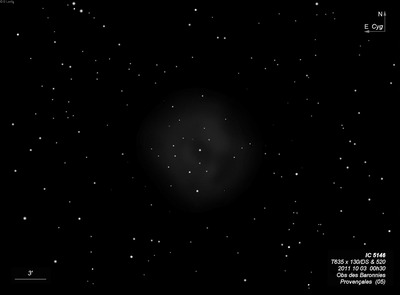Cocoon Nebula
Cocoon Nebula

E.E. Barnard discovered IC 5146 = Cocoon Nebula on a photograph taken 11 Oct 1893 using the 6" Willard lens at Lick Observatory. Max Wolf also photographed the field on 28 Jul 1894 with the 6-inch camera at Königstuhl. Wolf announced his discovery with a photograph taken on 10 Jul 1904 and discussed the dark lane (Barnard 168) and nebulosity in detail in his paper "Remarkable nebula in Cygnus" (MNRAS, 64, 838,1904).
Mary Clerke, who was in correspondence with Wolf at the time, includes Wolf's 1904 photograph (plate XX) in her second edition (1905) of "The System of the Stars". She labeled the photograph "The Cocoon Nebula in Cygnus" and writes (p. 352) "The depicted nebula, which had been discovered ten years previously, is about 10' in diameter, of a round shape, and a complex structure. "It is placed centrally," Dr. Wolf writes, "in a very fine lacuna void of faint stars, which surrounds the luminous cloud like a trench." Moreover, this negative "halo forms the end of a long channel, running eastward from the western nebulous clouds and their lucanae, to a length of more the two degrees." The coexistence in the same sidereal district of nebulae and stars could not well be asserted with stronger emphasis than by clearly of a dark fosse for the accommodation of the cocoon-like object in Plate XX." I tracked down the nickname after a discussion on AMASTRO in August 2015.
The Reverend Thomas Espin discovered the nebula visually on 13 Aug 1899 and described object #6 in AN [3633] 152, 141 as a "large, faint glow about 8', well seen each night [2]." Espin and Wolf is credited with the discovery in the IC.
Dave Riddle notes that B168 could apply to both the bright nebula and the associated dark lane. Barnard refers to a "small nebula at the E end of dark lane. This nebula is 10' in diameter with over a dozen stars of different magnitudes in it. There is no central condensation, nor does the nebula condense about any of the stars. There are some dark markings in it. The dark lane is 1.7 degrees long and 9' wide."
200/250mm - 8" (8/12/83): about 20 stars over a very faint "milky" region, fairly large, just slightly higher contrast than Milky Way background. A short arc of stars is off the west edge. A long starless dark lane extends west. Two bright stars oriented N-S are just east.
400/500mm - 17.5" (8/8/91): at 82x using an H-Beta filter, the Cocoon Nebula appears fairly bright, very large, about 10' diameter. Surrounds six stars including two bright mag 9-10 stars embedded near the center and at the south edge. Has an irregular round shape with a very irregular surface brightness with dark mottling and brighter regions. The nebula is quite prominent using an H-Beta filter, which gives an excellent contrast gain (higher than OIII). The nebulous glow is superimposed on a scattered star group and is situated at the east end of long dark lane = B168 which extends 1° WNW! (excellent in binoculars). There is a distinctive edge to the Milky Way on the north edge of lane.
Notes by Steve Gottlieb